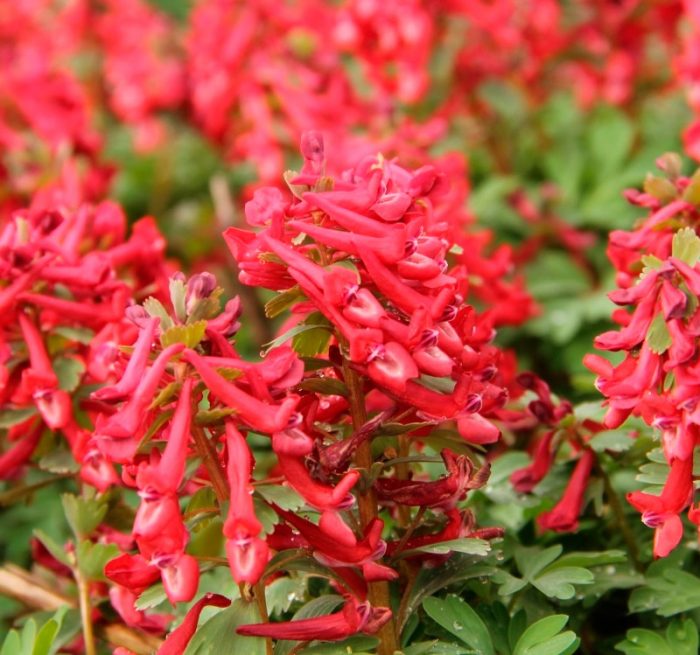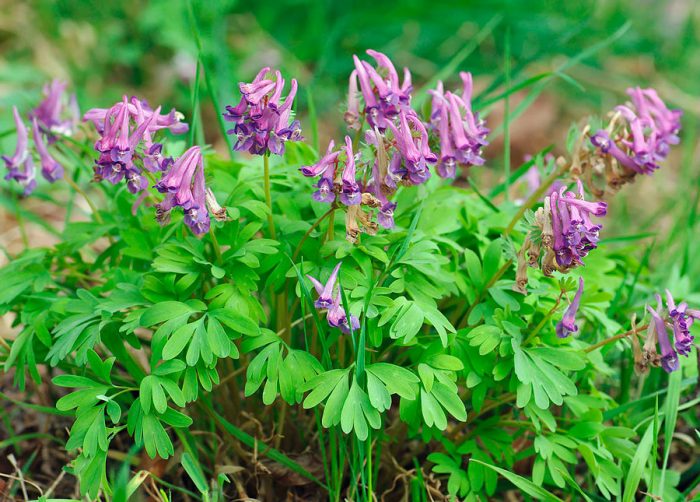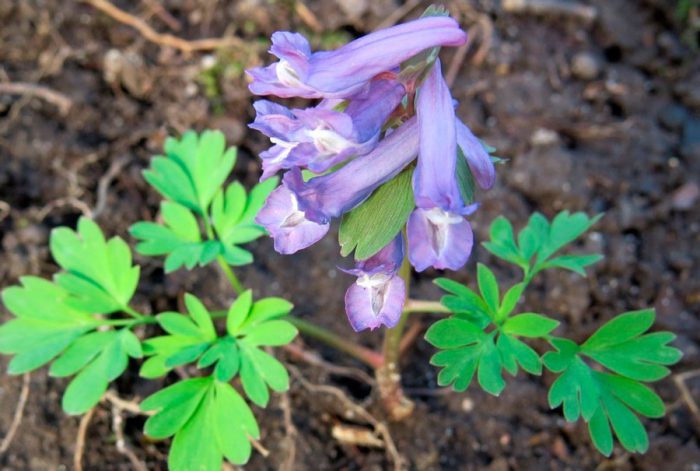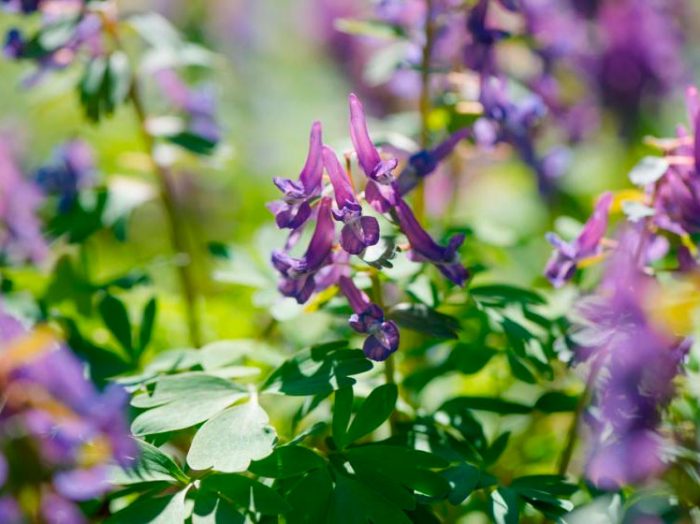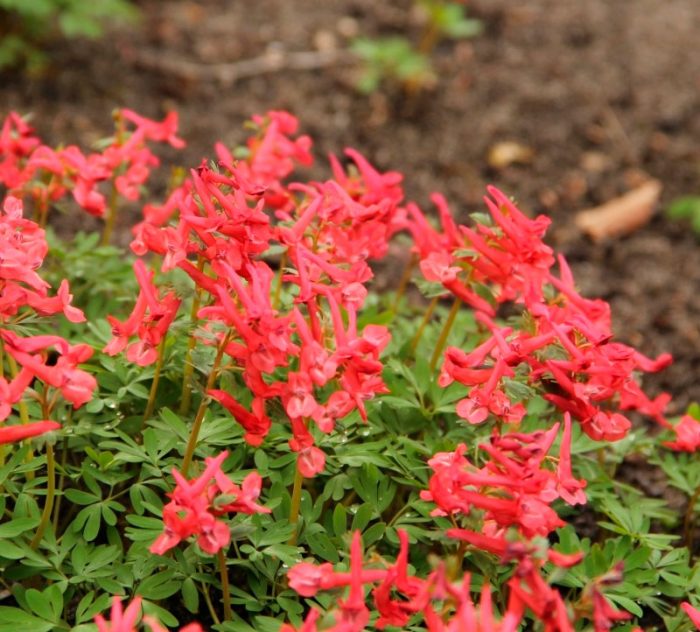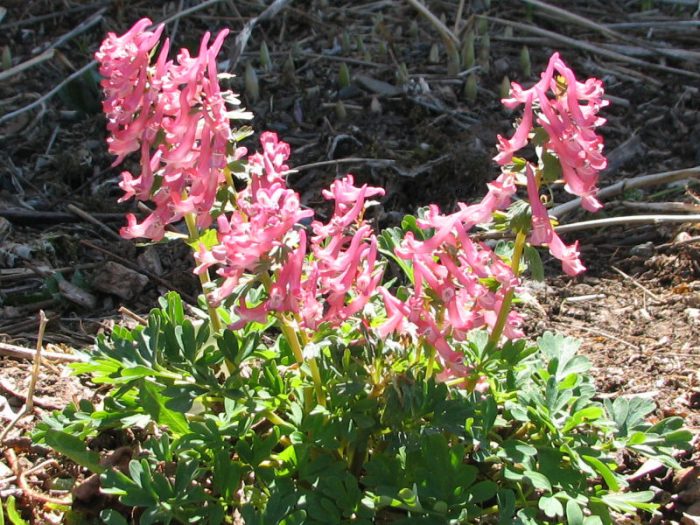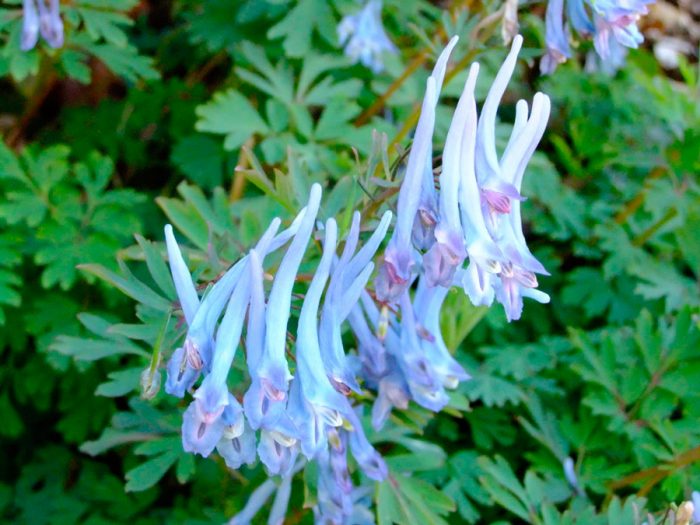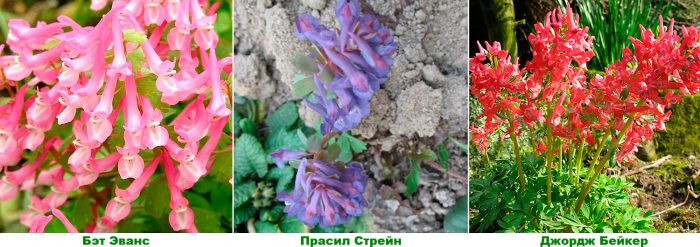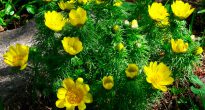The herbaceous corydalis (Corydalis) is a member of the Poppy family. It occurs naturally in regions with a temperate climate in the Northern Hemisphere. The scientific name of this plant is derived from the Greek word for "helmet", this is due to the shape of the flowers of the corydalis. This genus unites about 320 species. The greatest diversity of species (about 200) is observed in the territory of Central and Western China, as well as in the Himalayas, where the corydalis grow at an altitude of 3000–5000 meters above sea level. These plants began to be cultivated relatively recently, or rather, in the 19th century. They were previously imported from Central Asia, the Himalayas, Siberia, Tibet, but most often from China. Today they are quite popular among gardeners, as well as, for example, dahlias, tulips and phloxes. And all due to the fact that such a flower is not only very beautiful, but also resistant to frost and diseases, undemanding to care, and it also has medicinal properties.
Content
Corydalis features
The flowering Corydalis plant is a perennial and an annual. The rhizome of such a plant is quite massive, it is located at a rather great depth and consists of branched processes. On individual shoots, the formation of rounded tubers is sometimes observed, inside which there are nutrients. The height of erect shoots can vary from 0.15 to 0.45 m. At the base of the stems there are 2–4 fern-like leaf plates of a dark green color with a bluish bloom. Leaves can be twice or three times complex, the shape of the lobes is triangular or rounded, and each of them has its own petiole. The formation of racemose cylindrical inflorescences at the tops of the stems is observed in mid-April. The inflorescences include 5–35 long flowers that can be pink, lilac, white, purple or yellow. Flowers have corolla length from 1.5 to 2.5 centimeters, pointed sepals are small, and bracts are relatively large. All flowers have rather long spurs, inside of which there is nectar. It can be obtained only by those insects that have a long proboscis. The fruit is an oblong box with small glossy black seeds inside. Each seed has a fleshy growth that ants simply adore.As a result, ants can drag these seeds over a rather long distance.
Corydalis begins to grow in March. Its flowering begins after the soil warms up to 3-4 degrees. The flowering period is approximately 20 days. Seed ripening is observed in June, after which the part of the plant that is above the ground dies off. In landscape design, these plants are most often grown with other primroses, for example: crocuses, muscari, chionodox, galanthus and early tulips.
Corydalis planting in the open field
What time to plant
As a rule, corydalis planting material is sold at a time when its tubers are dormant, or rather, from the second half of June to September. It is during this period of time that it is recommended to plant this crop in open soil. The acquired planting material must be thoroughly examined. You should choose dense and juicy tubers. The tubers of the Central Asian species of this plant can be slightly dried, it does not harm them.
When choosing a site for planting, you should pay attention to which group the species of Corydalis you grow belongs to. So, for example, experts advise Chinese, mountain and alpine species to grow in an open, illuminated area, with well-drained sandy loam soil, while it should be located on a hill or hill. And it is recommended to plant forest species in a shaded area with loose humus soil. It must be necessarily neutral or slightly acidic.
Landing rules
There is nothing difficult in planting and growing the corydalis. Before planting, the site must be prepared. If the soil is dense and excessively heavy, then during digging, fine gravel or crushed stone must be added to it. It should be remembered that when moisture stagnates in the soil, rot forms very quickly on the roots. To avoid this, you should make sure that excess liquid drains off the site quickly enough.
The depth to which the tubers should be planted directly depends on their size. Large tubers should be planted to a depth of 10 to 15 centimeters, and small tubers should be buried 5-7 centimeters. The planted tubers need abundant watering.
Corydalis care in the garden
When growing the corydalis in the garden, it should be watered, weeded, fed, loosened the soil surface and protected from pests and diseases in a timely manner. However, it should be borne in mind that different types of care requirements and preferences may differ.
How to feed and water
In the first weeks of spring, when the corydalis begins to grow, as a rule, the soil is quite moist from melt water, so the plants will not need to be watered. After the earth dries out, the plants will need to be watered systematically. It should be borne in mind that alpine and desert species should be provided with moderate watering, as they react negatively to stagnant moisture in the root system, while a short drought does much less damage to the plant. It must be remembered that any of the corydalis species reacts extremely negatively to stagnant water in the soil, in this regard, the land on the site must be well-drained. When the bushes are watered, you need to loosen the surface of the site, while removing the weeds. To reduce the number of weeding, watering and loosening, the surface of the site must be covered with a layer of organic mulch.
Only forest species of corydalis need feeding, while compost or leaf humus should be added to the soil during digging before planting. Also in spring, you can mulch the surface of the site with organic matter.
After the bushes have faded, their parts located above the ground turn yellow over time, and their dying off is observed.To remember where they grew, you need to mark each bush by sticking a peg next to it. This culture is distinguished by a fairly high resistance to frost, so it does not need shelter for the winter. However, it should be borne in mind that the Chinese Corydalis can die if the air temperature drops below minus 23 degrees.
How to transplant and propagate
It is recommended to transplant this primrose during its rest period. But even during the flowering period, the Corydalis bushes tolerate this procedure quite well. However, when transplanting, a part of a flowering bush located above the ground can come off quite easily, in which case the tubers will begin a dormant period earlier than usual. They transfer the bushes to a new place along with a lump of earth.
For reproduction of such a plant, seeds, tubers, and also a method of dividing the rhizome are used. On the rhizomes, tubers are formed only on the corydalis of Kashmir and Bush. You can divide the rhizome in the spring, as well as from the middle to the end of the summer, and they do this during plant transplantation. When dividing a bush, it should be borne in mind that each delenka must have a renewal bud and a part of the rhizome. When planting delenoks, they are buried in the soil by 5-15 centimeters (depending on the size of the tubers), while a distance of at least 10 centimeters should be kept between the holes. But it should also be noted that this breeding method is not very popular with gardeners.
Unripe corydalis seeds should be sown. So, they should be painted black, but the boxes should still be green. Try to pick the pods in time, otherwise, when they are fully ripe and open, the seeds will spill out onto the surface of the site, where ants will quickly drag them away. The seeds remain viable for 7 days, so there is no need to tighten them with sowing. Seeds are sown in containers, which must be filled with a moistened substrate. Then they are transferred to a shady place and make sure that the soil mixture is always slightly damp. Seedlings can be planted in the garden after spring comes. Corydalis grown from seeds bloom for the first time after 2–4 years (depending on the species).
Diseases and pests
Corydalis are highly resistant to disease, so they rarely get sick. If there is stagnation of water in the root system, then this can cause the development of a fungal disease. Any culture can be infected with a viral disease, no matter how bad or good you care for it. Bushes affected by such a disease should be removed from the soil and destroyed, and the area where they were grown must be shed with a solution of potassium manganese, which must be strong enough. To cure a plant affected by a fungal disease, it must be sprayed with a fungicide solution.
Of the pests, mice and moles are dangerous to the crested. To get rid of them, it is necessary to place baits with poison on the surface of the site in several places.
Types and varieties of corydalis with photos and names
Specialists divide a large number of crested species according to environmental requirements that determine the type of agricultural technology. Forest species are the most unpretentious of all perennial corydalis species, for example: Bush's corydalis, smoky-leaved, large-flowered (giant), Magadan, low, deceptive (doubtful), intermediate, narrow-leaved, dense (Hallera), Caucasian, Kuznetsova, Marshall, Malka, bracts and placed (Turchaninov). For the cultivation of these species, it is recommended to choose areas with clay or sandy loam soil, saturated with leaf humus and humus. They grow best in grass in a clearing under deciduous trees, in a garden under fruit crops, as well as in permanent flower beds.
The most popular varieties are Haller's corydalis (dense), for example:
- Beth Evans... The flowers are painted in a delicate shade of pink, while the spur is white.
- Prasil Strain... It is a variety that includes varieties with flowers in various shades from salmon and pink to red.
- George Baker... The flowers are deep red, almost cherry-colored.
- Dieter Schacht... The flowers are pale pink.
- Highland Mix... Inflorescences are painted in a smoky pinkish-blue color.
- Munich Form... The flowers are colored coral red.
- Nettleton Pink... The inflorescences have a deep pink color.
Perennial species of the Himalayan deserts, highlands and foothills are less adapted for cultivation in mid-latitudes. They received a conditional name - mountain species. These include: Wilson's corydalis, Darvaz, Ledebour, Narinyan, Popova, rut-leaved, Severtsova, Emanuel, Kashmir, holosteel, large-spine, Marakand, Pachos, dissected-leaved, glaucous and Shangin.
Perennial rhizome species include sulfur-yellow, yellow and noble corydalis. Annual species are much less often cultivated, for example: touch-me-not corydalis and evergreen.
Not so long ago, highly decorative species originating from the Chinese region of Sichuan began to be cultivated in Europe, namely: the corydalis tall and winding. The most popular are the following varieties of Corydalis sinuous:
- Blue Panda... The leaf plates are colored in a light green-blue hue. The flowers are azure, the spurs are bent.
- Pearl Leaf... The color of the leaf plates is violet-red. On the shoots at the base of the leaves, there are spots of dark red color.
- China Blue... In winter, the foliage is green-brown. The length of the azure-greenish flowers is about 31 centimeters.
- Balang Mist... The color of the flowers is bluish.


Watch this video on YouTube

